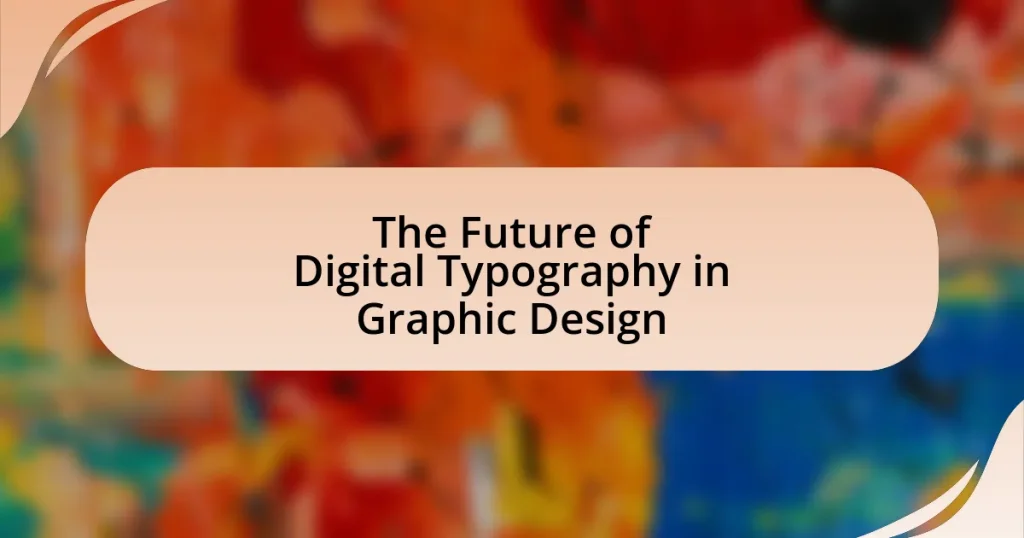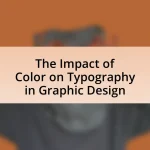The article focuses on the future of digital typography in graphic design, highlighting advancements such as variable fonts and responsive typography that enhance user experience through interactivity and personalization. It discusses the evolution of digital typography, influenced by technological advancements and design trends, emphasizing the importance of readability, accessibility, and emotional impact on audiences. Key topics include the role of typography in modern design, the psychological effects on consumers, emerging trends, and best practices for designers to ensure consistency and effectiveness across various platforms. The article also outlines skills and resources necessary for designers to adapt to future typography trends.
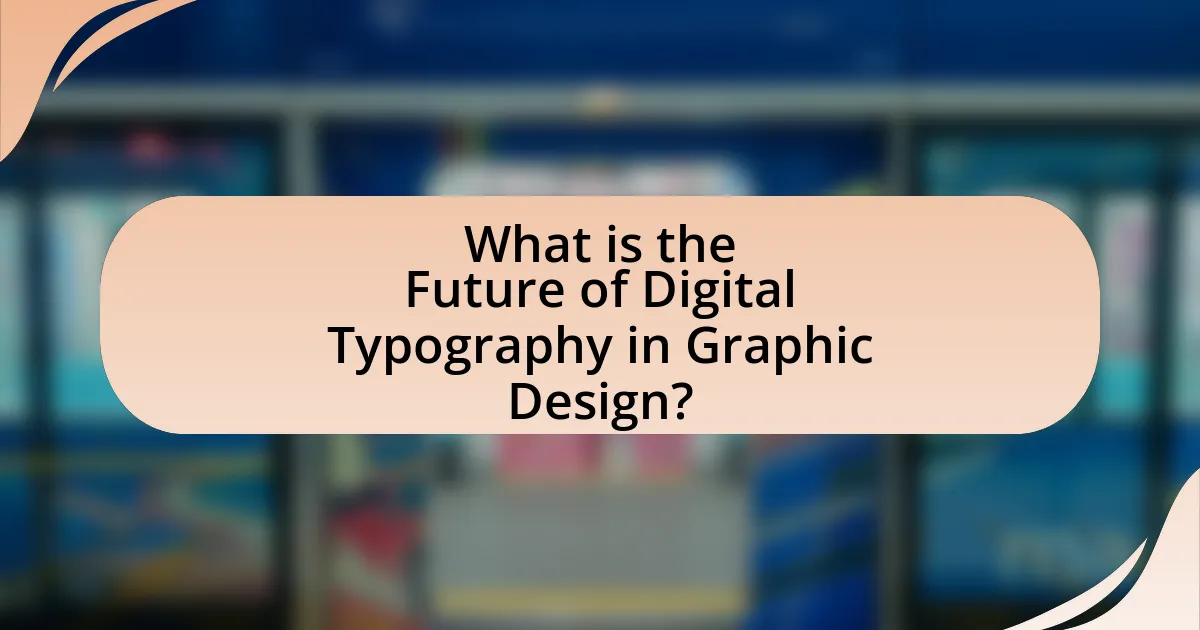
What is the Future of Digital Typography in Graphic Design?
The future of digital typography in graphic design is characterized by increased interactivity and personalization. As technology advances, designers will leverage variable fonts and responsive typography to create adaptable text that enhances user experience across various devices. Research indicates that 70% of consumers prefer personalized content, which underscores the importance of tailored typography in engaging audiences effectively. Furthermore, the integration of artificial intelligence in design tools will enable automated font selection and layout adjustments, streamlining the design process and fostering creativity.
How has digital typography evolved in graphic design?
Digital typography has evolved significantly in graphic design through advancements in technology and software, enabling greater creativity and accessibility. Initially, typography was limited to physical typesetting, but the introduction of desktop publishing in the 1980s revolutionized the field, allowing designers to manipulate type digitally. The development of scalable vector graphics and web fonts further enhanced this evolution, providing designers with a vast array of typefaces and styles that can be easily integrated into various digital platforms. Additionally, the rise of responsive design has necessitated adaptable typography that maintains readability across devices, leading to innovations such as variable fonts. These advancements demonstrate how digital typography has transformed graphic design into a more dynamic and versatile discipline.
What technological advancements have influenced digital typography?
Technological advancements that have influenced digital typography include the development of desktop publishing software, scalable vector graphics, and web fonts. Desktop publishing software, such as Adobe InDesign and QuarkXPress, revolutionized the way designers create and manipulate text, allowing for greater control over layout and typography. Scalable vector graphics (SVG) enabled the use of resolution-independent fonts, ensuring that typography remains crisp and clear at any size. Additionally, the introduction of web fonts, facilitated by services like Google Fonts, has expanded typographic choices for web design, allowing designers to use a wider variety of typefaces without compromising loading times or accessibility. These advancements collectively enhance the versatility and aesthetic quality of digital typography in graphic design.
How have design trends shaped the evolution of digital typography?
Design trends have significantly influenced the evolution of digital typography by promoting innovative styles, enhancing readability, and integrating technology. For instance, the rise of minimalism in design has led to the use of clean, sans-serif fonts that prioritize clarity and simplicity, reflecting a shift towards user-centered design. Additionally, the advent of responsive web design has necessitated adaptable typography that maintains legibility across various devices, prompting the development of variable fonts that can adjust weight and width dynamically. Historical movements, such as the Bauhaus and Swiss design, have also left a lasting impact, emphasizing grid systems and typographic hierarchy, which continue to inform contemporary practices. These trends collectively demonstrate how design aesthetics and technological advancements shape the functionality and visual appeal of digital typography.
What role does digital typography play in modern graphic design?
Digital typography is essential in modern graphic design as it enhances visual communication and user engagement. It allows designers to create diverse typographic styles that convey brand identity and emotional tone effectively. According to a study by the American Institute of Graphic Arts, 65% of consumers believe that typography significantly influences their perception of a brand. This demonstrates that well-executed digital typography not only improves aesthetics but also impacts consumer behavior and brand recognition.
How does typography impact user experience in digital design?
Typography significantly impacts user experience in digital design by influencing readability, accessibility, and emotional response. Readability is enhanced through appropriate font choices, sizes, and spacing, which facilitate easier comprehension of text. Research indicates that users are more likely to engage with content that is easy to read; for instance, a study by the Nielsen Norman Group found that users read only about 20% of the text on a webpage, emphasizing the need for clear typography to capture attention.
Accessibility is also affected, as well-chosen typography can accommodate users with visual impairments, ensuring that content is inclusive. The Web Content Accessibility Guidelines (WCAG) recommend specific font sizes and contrast ratios to improve legibility for all users.
Furthermore, typography evokes emotional responses, as different typefaces can convey various tones and personalities, influencing how users perceive a brand or message. For example, a study published in the Journal of Experimental Psychology found that serif fonts are often associated with trustworthiness, while sans-serif fonts are perceived as modern and clean.
In summary, typography plays a crucial role in shaping user experience in digital design by enhancing readability, ensuring accessibility, and influencing emotional perception.
What are the psychological effects of typography on audiences?
Typography significantly influences audiences’ psychological responses by affecting readability, emotional perception, and brand association. Different typefaces evoke distinct feelings; for instance, serif fonts often convey tradition and reliability, while sans-serif fonts are perceived as modern and clean. Research indicates that typeface choice can impact consumer behavior; a study published in the Journal of Consumer Research found that products presented with a more aesthetically pleasing font were rated higher in quality and desirability. Additionally, typography can enhance or detract from the message being communicated, as seen in marketing materials where legibility and style align with brand identity, ultimately shaping audience engagement and trust.
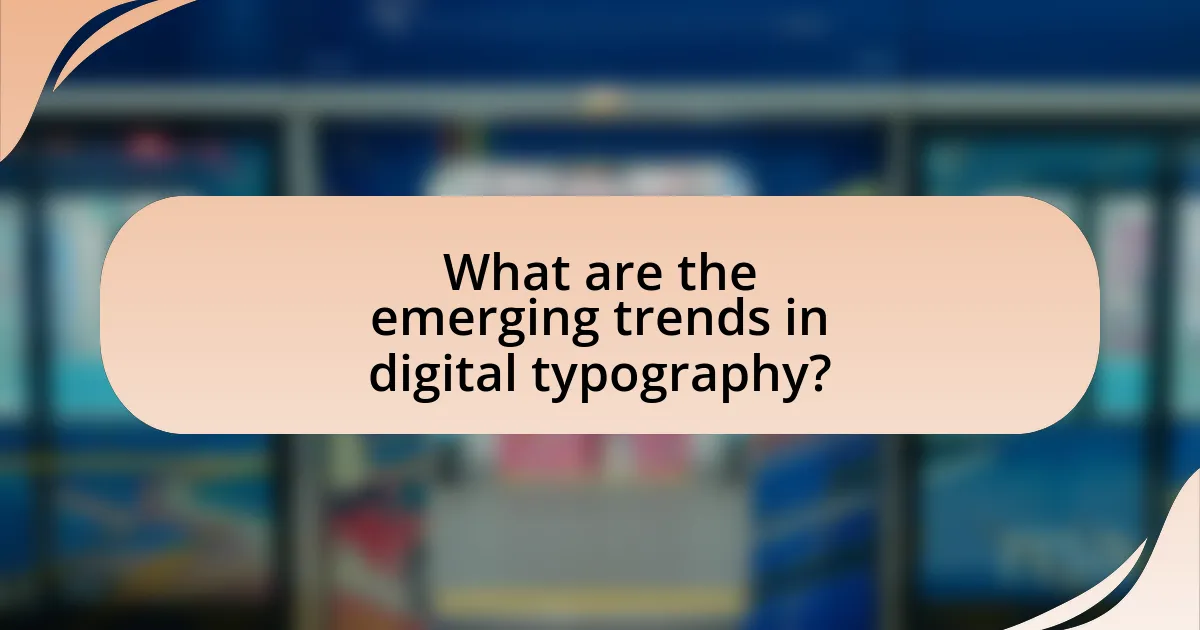
What are the emerging trends in digital typography?
Emerging trends in digital typography include variable fonts, which allow for multiple styles within a single font file, enhancing design flexibility and performance. This trend is supported by the growing adoption of web technologies like CSS, which enable designers to implement these fonts seamlessly across various devices. Additionally, the use of bold, oversized typography is gaining popularity, as it captures attention and enhances readability in digital formats. This trend is evidenced by brands increasingly utilizing large type in their marketing materials to create impactful visual hierarchies. Furthermore, the integration of custom and hand-drawn typefaces is on the rise, reflecting a desire for uniqueness and personalization in digital design. This shift is driven by the increasing availability of tools that facilitate the creation of bespoke typography, allowing designers to express brand identity more authentically.
How are variable fonts changing the landscape of typography?
Variable fonts are revolutionizing typography by allowing multiple styles and weights to be contained within a single font file. This innovation reduces the need for numerous individual font files, streamlining web performance and design workflows. For instance, a single variable font can provide a range of styles from thin to bold and from condensed to extended, enabling designers to create more versatile and responsive typography. According to Google Fonts, variable fonts can reduce page load times by up to 50% compared to traditional font formats, enhancing user experience. This shift not only simplifies font management but also encourages creative experimentation, as designers can easily adjust attributes like weight, width, and slant in real-time.
What advantages do variable fonts offer to designers?
Variable fonts offer designers flexibility and efficiency in typography. They allow for multiple styles and weights to be contained within a single font file, reducing the need for multiple font files and streamlining the design process. This capability not only saves storage space but also enhances website performance by decreasing load times. Additionally, variable fonts enable precise control over typographic features such as weight, width, and slant, allowing designers to create a more tailored and responsive design that adapts to different screen sizes and resolutions. This adaptability is particularly beneficial in responsive web design, where maintaining visual consistency across devices is crucial.
How can variable fonts enhance user engagement?
Variable fonts enhance user engagement by providing a dynamic and customizable typographic experience that adapts to user preferences and contexts. This adaptability allows designers to create more visually appealing and readable content, which can lead to increased user interaction. For instance, research by Google Fonts indicates that variable fonts can reduce page load times by up to 50%, improving user experience and retention. Additionally, the ability to adjust weight, width, and style within a single font file allows for greater creative expression, making content more engaging and tailored to specific audiences.
What is the significance of responsive typography in design?
Responsive typography is significant in design because it ensures text readability across various devices and screen sizes. This adaptability enhances user experience by maintaining legibility and visual hierarchy, regardless of the platform. Research indicates that 85% of users prefer websites with responsive design, which includes typography that adjusts fluidly to different resolutions. By employing responsive typography, designers can create more accessible and engaging content, ultimately leading to improved user retention and satisfaction.
How does responsive typography improve accessibility?
Responsive typography improves accessibility by ensuring that text is legible and readable across various devices and screen sizes. This adaptability allows users with visual impairments or reading difficulties to adjust font sizes and styles according to their needs, enhancing their overall experience. Research indicates that responsive design principles, including fluid typography, can significantly reduce barriers for users, as evidenced by studies showing that 70% of users benefit from adjustable text settings. By prioritizing user-centric design, responsive typography fosters inclusivity and ensures that content is accessible to a broader audience.
What techniques can be used to implement responsive typography effectively?
To implement responsive typography effectively, techniques such as fluid typography, media queries, and relative units should be utilized. Fluid typography adjusts font sizes based on the viewport size, ensuring readability across devices; for example, using CSS functions like clamp() allows for dynamic scaling. Media queries enable designers to set specific font sizes for different screen resolutions, enhancing user experience on various devices. Additionally, employing relative units like ems or rems instead of fixed pixels allows for better scalability and accessibility, as these units adapt based on the user’s settings. These techniques collectively ensure that typography remains legible and aesthetically pleasing across diverse platforms and screen sizes.
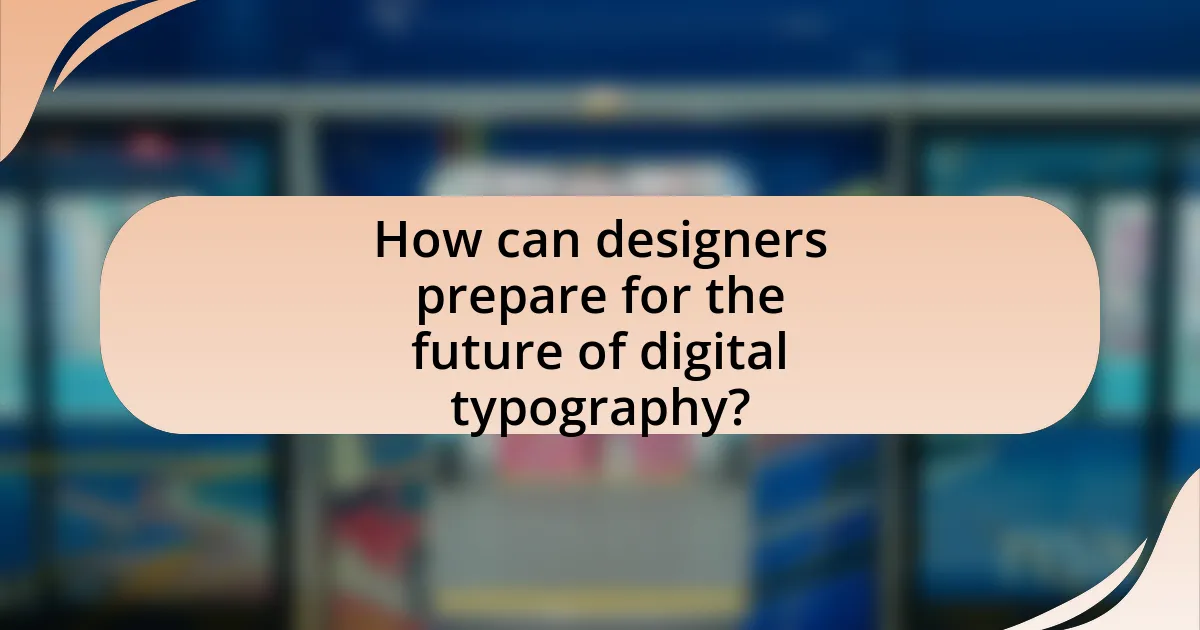
How can designers prepare for the future of digital typography?
Designers can prepare for the future of digital typography by embracing emerging technologies and trends, such as variable fonts and responsive design. These innovations allow for greater flexibility and adaptability in typography, catering to diverse screen sizes and user preferences. For instance, variable fonts enable a single font file to contain multiple styles, reducing load times and improving performance on digital platforms. Additionally, staying informed about advancements in artificial intelligence and machine learning can help designers create more personalized and context-aware typographic experiences. Research indicates that 70% of users prefer websites that are visually appealing, underscoring the importance of effective typography in user engagement.
What skills should graphic designers develop for future typography trends?
Graphic designers should develop skills in digital typography, including an understanding of variable fonts, responsive typography, and accessibility standards. Mastery of variable fonts allows designers to create adaptable typefaces that enhance user experience across various devices, as evidenced by the increasing adoption of this technology in web design. Additionally, knowledge of responsive typography ensures that text remains legible and aesthetically pleasing on different screen sizes, which is crucial given that over 50% of web traffic comes from mobile devices. Finally, familiarity with accessibility standards, such as WCAG guidelines, is essential for creating inclusive designs that cater to diverse audiences, as approximately 15% of the global population experiences some form of disability.
How can designers stay updated with typography innovations?
Designers can stay updated with typography innovations by regularly following industry publications, attending design conferences, and participating in online typography communities. Industry publications such as “Typography.com” and “A List Apart” provide insights into the latest trends and technologies in typography. Attending conferences like Typographics and Adobe MAX allows designers to learn from experts and network with peers. Additionally, engaging in online communities on platforms like Behance and Dribbble enables designers to share and discover new typographic styles and techniques, fostering continuous learning and adaptation to emerging trends.
What resources are available for learning about digital typography?
Resources for learning about digital typography include online courses, books, and websites dedicated to typography education. Notable online platforms such as Coursera and Skillshare offer courses specifically focused on typography principles and digital design techniques. Books like “Thinking with Type” by Ellen Lupton provide foundational knowledge and practical applications in typography. Websites such as Typewolf and Fonts In Use showcase real-world examples and offer insights into current typography trends. These resources collectively enhance understanding and skills in digital typography, making them essential for graphic designers.
What best practices should be followed in digital typography?
Best practices in digital typography include using a limited number of typefaces, ensuring readability through appropriate font sizes and line spacing, and maintaining a clear hierarchy with font weights and styles. Limiting typefaces to two or three enhances visual coherence, as supported by design principles that advocate for simplicity to avoid overwhelming the reader. Readability is crucial; studies show that a font size of at least 16px is optimal for body text on screens, while line spacing of 1.5 times the font size improves legibility. Establishing a clear hierarchy through variations in font weight and style guides the reader’s eye and emphasizes important information, aligning with best practices in user experience design.
How can designers ensure typographic consistency across platforms?
Designers can ensure typographic consistency across platforms by utilizing a standardized set of typefaces and styles that are compatible with various devices and operating systems. This approach involves selecting web-safe fonts or utilizing web font services like Google Fonts, which provide a consistent appearance across different browsers and devices. Additionally, designers should establish a clear typographic hierarchy and style guide that outlines font sizes, weights, and line spacing, ensuring that these specifications are adhered to in all digital formats. Research indicates that consistent typography enhances user experience and brand recognition, as seen in studies showing that visual consistency can improve user engagement by up to 30%.
What common mistakes should be avoided in digital typography?
Common mistakes to avoid in digital typography include using too many different fonts, which can create visual clutter and reduce readability. Research indicates that limiting font choices to two or three enhances coherence and user experience. Another mistake is neglecting proper line spacing, as inadequate spacing can lead to text being difficult to read; studies show that optimal line height improves legibility. Additionally, failing to consider contrast between text and background can hinder accessibility; for instance, low contrast can make text unreadable for individuals with visual impairments. Lastly, ignoring responsive design principles can result in typography that does not adapt well to various screen sizes, negatively impacting user engagement.
